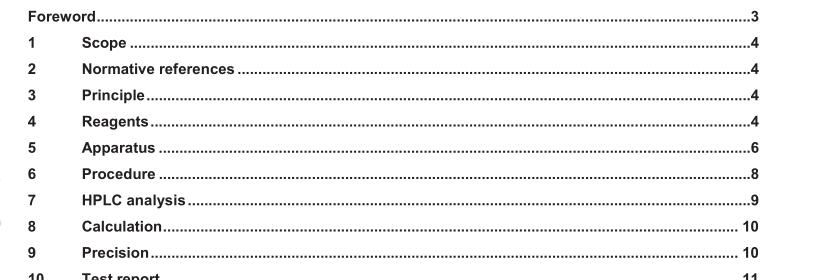EN 15890:2010 – Foodstuffs – Determination of patulin in fruit juice and fruit based purée for infants and young children – HPLC method with liquid/liquid partition cleanup and solid phase extraction and UV detection

1 Scope
This European Standard specifies a method for the determination of patulin in fruit juices and fruit-based purée, such as baby food purée, using high performance liquid chromatography with ultra-violet detection (HPLC-UV). Using naturally contaminated and spiked samples this method has been validated for the determination of patulin in apple juice, at levels ranging from 3,0 µg/kg to 15,5 µg/kg, and in fruit-based baby food purée, at levels ranging from 3,4 µg/kg to 17,9 µg/kg. Baby food fruit purée used in this study contained a mixture of the following ingredients which are commercially available on the European market: blueberry; apple; banana; lemon; wheat biscuits; wheat syrup; whole milk; and vegetable oil.
A detailed listing, including the fractions, of each product used in this study is given in [1]. Further information on validation, see Clause 9 and Annex B.
2 Normative references
The following referenced documents are indispensable for the application of this document. For dated references, only the edition cited applies. For undated references, the latest edition of the referenced document (including any amendments) applies.
EN ISO 3696:1995, Water for analytical laboratory use ― Specification and test methods (ISO 3696:1987)
3 Principle
Patulin is extracted from apple juice, or fruit-based purée, with a mixture of ethyl-acetate and hexane in the presence of sodium sulfate and sodium hydrogen carbonate. An aliquot of the extract is purified by solid-phase extraction and evaporated. The residue is re-dissolved in water of pH = 4 and patulin is separated by reverse phase (RP)-HPLC and quantitatively determined by UV detection.
4 Reagents
4.1 General Use only reagents of recognized analytical grade and water complying with grade 1 of EN ISO 3696:1995, unless otherwise specified. Solvents shall be of quality for HPLC analysis, unless otherwise specified. Commercially available solutions with equivalent properties to the reagents listed may be used.
4.2 Perchloric acid, the mass fraction w(HClO 4 ) ≥ 60 % in water.
4.3 Sand, 50 mesh to 70 mesh particle size.
4.4 Silicagel solid phase extraction (SPE) cartridges (500 mg SiO 2 ).
4.5 Sodium sulfate anhydrous, Na 2 SO 4 .
4.6 Sodium hydrogen carbonate, NaHCO 3 .
4.7 Glacial acetic acid, w(CH 3 COOH) ≈ 98 % in water.
4.8 Water of pH = 4.
Adjust water to pH = 4 with glacial acetic acid (4.7).
4.9 Absolute ethanol, w(CH 3 CH 2 OH) ≥ 99,7 % in water.
4.10 Acetonitrile.
WARNING — Acetonitrile is hazardous and samples shall be blended using an explosion proof blender which is housed within a fume cupboard. After blending, samples shall be filtered inside a fume cupboard.
4.11 Ethyl acetate.
4.12 n-Hexane.
4.13 Extraction solvent.
Add 60 ml of ethyl acetate (4.11) to 40 ml of n-hexane (4.12).
4.14 Mixture of glacial acetic acid and ethyl acetate.
Add 3 ml of glacial acetic acid (4.7) to 97 ml of ethyl acetate (4.11).
EN 15890:2010 – Foodstuffs – Determination of patulin in fruit juice and fruit based purée for infants and young children – HPLC method with liquid/liquid partition cleanup and solid phase extraction and UV detection